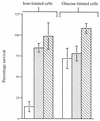Iron-limited biofilms of Candida albicans and their susceptibility to amphotericin B
- PMID: 9687427
- PMCID: PMC105891
- DOI: 10.1128/AAC.42.8.2146
Iron-limited biofilms of Candida albicans and their susceptibility to amphotericin B
Abstract
Biofilms of Candida albicans were grown in vitro under iron limitation and at a low growth rate to simulate conditions for implant-associated biofilms in vivo. Their properties were compared with those of glucose-limited biofilms grown under analogous conditions. At steady state, the adherent cell populations of iron-limited biofilms were double those of glucose-limited biofilms, although the growth rates were similar (0.038 to 0.043 h-1). Both biofilm types were resistant to amphotericin B, but daughter cells from iron-limited biofilms were significantly more susceptible to the drug than those from glucose-limited biofilms.
Figures



 ),
and biofilm daughter cells (□) were exposed to amphotericin B for
1 h, and the percent survival was estimated by viable counts.
Results are means ± standard errors of the means from three
independent experiments with viable counts done in triplicate.
),
and biofilm daughter cells (□) were exposed to amphotericin B for
1 h, and the percent survival was estimated by viable counts.
Results are means ± standard errors of the means from three
independent experiments with viable counts done in triplicate.References
-
- Allison D G, Brown M R W, Evans D E, Gilbert P. Surface hydrophobicity and dispersal of Pseudomonas aeruginosafrom biofilms. FEMS Microbiol Lett. 1990;71:101–104. - PubMed
-
- Brown M R W, Gilbert P. Sensitivity of biofilms to antimicrobial agents. J Appl Bacteriol. 1993;74(Symp. Suppl.):87S–97S. - PubMed
-
- Brown M R W, Williams P. The influence of environment on envelope properties affecting survival of bacteria in infections. Annu Rev Microbiol. 1985;39:527–556. - PubMed
Publication types
MeSH terms
Substances
LinkOut - more resources
Full Text Sources
Other Literature Sources
Medical

